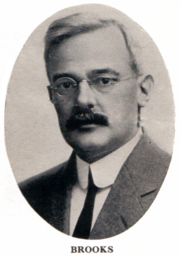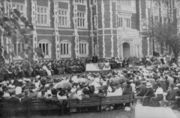
Stratton D. Brooks
Encyclopedia

University of Oklahoma
The University of Oklahoma is a coeducational public research university located in Norman, Oklahoma. Founded in 1890, it existed in Oklahoma Territory near Indian Territory for 17 years before the two became the state of Oklahoma. the university had 29,931 students enrolled, most located at its...
and eleventh president of the University of Missouri
University of Missouri
The University of Missouri System is a state university system providing centralized administration for four universities, a health care system, an extension program, five research and technology parks, and a publishing press. More than 64,000 students are currently enrolled at its four campuses...
.
Early life
Stratton Brooks was born in 1870 in Everett, Missouri. At the age of two, he and his parents moved to MichiganMichigan
Michigan is a U.S. state located in the Great Lakes Region of the United States of America. The name Michigan is the French form of the Ojibwa word mishigamaa, meaning "large water" or "large lake"....
where his father, Charles Brooks, was a Sheriff in Isabella Co. Michigan (1878-82) Stratton Brooks graduated from Mt. Pleasant High School, Mt. Pleasant, Michigan class of 1887 Brooks was educated at the University of Michigan
University of Michigan
The University of Michigan is a public research university located in Ann Arbor, Michigan in the United States. It is the state's oldest university and the flagship campus of the University of Michigan...
and held a master's degree
Master's degree
A master's is an academic degree granted to individuals who have undergone study demonstrating a mastery or high-order overview of a specific field of study or area of professional practice...
from Harvard University
Harvard University
Harvard University is a private Ivy League university located in Cambridge, Massachusetts, United States, established in 1636 by the Massachusetts legislature. Harvard is the oldest institution of higher learning in the United States and the first corporation chartered in the country...
. Prior to being appointed president of the University of Oklahoma, he had been superintendent of Boston
Boston
Boston is the capital of and largest city in Massachusetts, and is one of the oldest cities in the United States. The largest city in New England, Boston is regarded as the unofficial "Capital of New England" for its economic and cultural impact on the entire New England region. The city proper had...
public schools.
University of Oklahoma
When Brooks was first being courted for the position of OU president in 1911, he at first did not want the position. It was seen as a fledging university and many on the East Coast were "still in shock" at the summary discharge of former president David Ross BoydDavid Ross Boyd
David Ross Boyd was an American educator and the first president of the University of Oklahoma.He was born in Coshocton, Ohio, and after obtaining a doctorate degree from the small Wooster University, where he was a member of the Beta Theta Pi Fraternity. He began his career early as a...
. He wasn't approached again until 1912 while at a national superintendent's meetings in St. Louis, Missouri
St. Louis, Missouri
St. Louis is an independent city on the eastern border of Missouri, United States. With a population of 319,294, it was the 58th-largest U.S. city at the 2010 U.S. Census. The Greater St...
. He was approached by William A. Brandenberg who was a member of the new Oklahoma State Board of Education. Again, Brooks refused the job but Brandenberg continued to pursue telling him that the Board desired to keep politics out of the selection process. Brooks still refused but gave advice on how to keep politics out of the process by saying that only the university president could appoint faculty and that the Board should have nothing to do with the administration of the university. Eventually, the Board agreed to these guidelines and was able to convince Brooks to accept the position. Brooks later said that, "Whatever was accomplished during my eleven years as president of the University, was possible only because the Board of Education that appointed me, and its successors, never violated the basic principles set forth in that first conference."

Gaylord Family Oklahoma Memorial Stadium
The Gaylord Family - Oklahoma Memorial Stadium is the on-campus football facility for the University of Oklahoma Sooners in Norman, Oklahoma. The official capacity of the stadium, following recent renovations, is 82,112, making it the 16th largest college stadium in the United States and the third...
and armory now stand. Brooks had a great reputation with the Board of Education (now the Board of Regents) and the Oklahoma legislature. During his years as president, many building were constructed around campus.
Brooks' was also OU's first wartime president, have served during the duration of World War I
World War I
World War I , which was predominantly called the World War or the Great War from its occurrence until 1939, and the First World War or World War I thereafter, was a major war centred in Europe that began on 28 July 1914 and lasted until 11 November 1918...
. He made many efforts to see that the university was at the forefront of preparedness for all war needs. He imposed strict food regulations on the university and he established thirteen courses in seven different departments for the direct purpose of "training soldiers, training men who expect to become soldiers, and training people who take the place of soldiers in civil life." Some of these courses included: wire telegraphy
Telegraphy
Telegraphy is the long-distance transmission of messages via some form of signalling technology. Telegraphy requires messages to be converted to a code which is known to both sender and receiver...
, wireless telegraphy
Wireless telegraphy
Wireless telegraphy is a historical term used today to apply to early radio telegraph communications techniques and practices, particularly those used during the first three decades of radio before the term radio came into use....
, stenography and shorthand
Shorthand
Shorthand is an abbreviated symbolic writing method that increases speed or brevity of writing as compared to a normal method of writing a language. The process of writing in shorthand is called stenography, from the Greek stenos and graphē or graphie...
, oxyacetylene welding
Welding
Welding is a fabrication or sculptural process that joins materials, usually metals or thermoplastics, by causing coalescence. This is often done by melting the workpieces and adding a filler material to form a pool of molten material that cools to become a strong joint, with pressure sometimes...
, orthopedic surgery
Orthopedic surgery
Orthopedic surgery or orthopedics is the branch of surgery concerned with conditions involving the musculoskeletal system...
, military field engineering, and first aid
First aid
First aid is the provision of initial care for an illness or injury. It is usually performed by non-expert, but trained personnel to a sick or injured person until definitive medical treatment can be accessed. Certain self-limiting illnesses or minor injuries may not require further medical care...
courses. Students under 21 were required to take special courses in the Student Army Training Corps. Barracks
Barracks
Barracks are specialised buildings for permanent military accommodation; the word may apply to separate housing blocks or to complete complexes. Their main object is to separate soldiers from the civilian population and reinforce discipline, training and esprit de corps. They were sometimes called...
, an infirmary
Hospital
A hospital is a health care institution providing patient treatment by specialized staff and equipment. Hospitals often, but not always, provide for inpatient care or longer-term patient stays....
, bathhouse
Public bathing
Public baths originated from a communal need for cleanliness. The term public may confuse some people, as some types of public baths are restricted depending on membership, gender, religious affiliation, or other reasons. As societies have changed, public baths have been replaced as private bathing...
, guardhouse
Guardhouse
A guardhouse is a building used to house personnel and security equipment...
, and canteen were constructed. By the latter part of 1918, the university was practically a military base. All in all, 30 faculty members, 500 alumni, and 1,875 students were in military service during the war.
University of Missouri
Brooks held his job as OU president until 1923 when he accepted a job as the president of the University of MissouriUniversity of Missouri
The University of Missouri System is a state university system providing centralized administration for four universities, a health care system, an extension program, five research and technology parks, and a publishing press. More than 64,000 students are currently enrolled at its four campuses...
, a job he held until 1931. He was buried in Norman
Norman, Oklahoma
Norman is a city in Cleveland County, Oklahoma, United States, and is located south of downtown Oklahoma City. It is part of the Oklahoma City metropolitan area. As of the 2010 census, Norman was to have 110,925 full-time residents, making it the third-largest city in Oklahoma and the...
.

